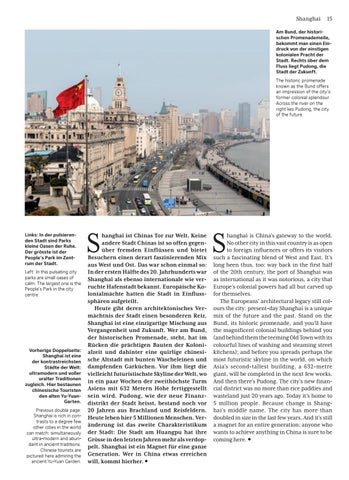Shanghai 15 Am Bund, der historischen Promenademeile, bekommt man einen Eindruck von der einstigen kolonialen Pracht der Stadt. Rechts über dem Fluss liegt Pudong, die Stadt der Zukunft.
The historic promenade known as the Bund offers an impression of the city’s former colonial splendour. Across the river on the right lies Pudong, the city of the future.
Links: In der pulsierenden Stadt sind Parks kleine Oasen der Ruhe. Der grösste ist der People’s Park im Zentrum der Stadt.
Left: In this pulsating city parks are small oases of calm. The largest one is the People’s Park in the city centre.
Vorherige Doppelseite: Shanghai ist eine der kontrastreichsten Städte der Welt: ultramodern und voller uralter Traditionen zugleich. Hier bestaunen chinesische Touristen den alten Yu-Yuan- Garten.
Previous double page: Shanghai is rich in contrasts to a degree few other cities in the world can match: simultaneously ultra-modern and abundant in ancient traditions. Chinese tourists are pictured here admiring the ancient Yu-Yuan Garden.
S
hanghai ist Chinas Tor zur Welt. Keine andere Stadt Chinas ist so offen gegen über fremden Einflüssen und bietet Besuchern einen derart faszinierenden Mix aus West und Ost. Das war schon einmal so: In der ersten Hälfte des 20. Jahrhunderts war Shanghai als ebenso internationale wie ver ruchte Hafenstadt bekannt. Europäische Ko lonialmächte hatten die Stadt in Einfluss sphären aufgeteilt. Heute gibt deren architektonisches Ver mächtnis der Stadt einen besonderen Reiz. Shanghai ist eine einzigartige Mischung aus Vergangenheit und Zukunft. Wer am Bund, der historischen Promenade, steht, hat im Rücken die prächtigen Bauten der Koloni alzeit und dahinter eine quirlige chinesische Altstadt mit bunten Wäscheleinen und dampfenden Garküchen. Vor ihm liegt die vielleicht futuristischste Skyline der Welt, wo in ein paar Wochen der zweithöchste Turm Asiens mit 632 Metern Höhe fertiggestellt sein wird. Pudong, wie der neue Finanz distrikt der Stadt heisst, bestand noch vor 20 Jahren aus Brachland und Reisfeldern. Heute leben hier 5 Millionen Menschen. Ver änderung ist das zweite Charakteristikum der Stadt: Die Stadt am Huangpu hat ihre Grösse in den letzten Jahren mehr als verdop pelt. Shanghai ist ein Magnet für eine ganze Generation. Wer in China etwas erreichen will, kommt hierher.
·
S
hanghai is China’s gateway to the world. No other city in this vast country is as open to foreign influences or offers its visitors such a fascinating blend of West and East. It’s long been thus, too: way back in the first half of the 20th century, the port of Shanghai was as international as it was notorious, a city that Europe’s colonial powers had all but carved up for themselves. The Europeans’ architectural legacy still colours the city: present-day Shanghai is a unique mix of the future and the past. Stand on the Bund, its historic promenade, and you’ll have the magnificent colonial buildings behind you (and behind them the teeming Old Town with its colourful lines of washing and steaming street kitchens); and before you spreads perhaps the most futuristic skyline in the world, on which Asia’s second-tallest building, a 632-metre giant, will be completed in the next few weeks. And then there’s Pudong. The city’s new financial district was no more than rice paddies and wasteland just 20 years ago. Today it’s home to 5 million people. Because change is Shanghai’s middle name. The city has more than doubled in size in the last few years. And it’s still a magnet for an entire generation: anyone who wants to achieve anything in China is sure to be coming here.
·
